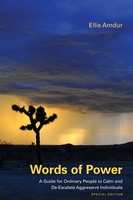 | Aggression touches all of our lives. Whether it is a customer or angry coworker, an upset family member, a fellow student at school or college, or a stranger we bump into on the street, all of us must deal with aggressive people. Words of Power is written for ordinary people who may, on occasion, have to deal with an angry, even an enraged person. This book was written with the help of a unique cadre of critical readers. Rather than specialists, they are people from ordinary walks of life who are not in a profession or life-situation where they must interact on a regular basis with aggressive people. Through their critique, this book focuses on the information that ordinary people need: no more, no less. The book is simple without being simplistic. It is a comprehensive guidebook on how to de-escalate angry people and how to use verbal control tactics to manage the behaviors of enraged people. Words of Power also teaches how to develop your intuition, so that you become aware and can react before something has truly become dangerous. Most importantly, this book teaches how to calm and center yourself so that you have access to your best, most powerful qualities. You have the best chance of achieving peace when you embody peace. Download Table of Contents and sample chapters. |
||
| Audible | Amazon Kindle | Amazon Paperback | |
A Review from Andrew Shinn
“…be both non-threatening and non-threatened.” This quote from the book is my new mantra. Actually, it’s a clearly-worded formulation of my general approach to life, social interaction, and conflict. But like so much in this volume, the clarity it brings to my thoughts and feelings is empowering.
Each of us has different roles in life. Some of mine include husband, father, and employee at a large public institution. In each of these roles, I have been confronted with angry individuals and conflict. Like the time someone rear-ended me while my 4 year old was in the car, and that driver tried to escalate the situation in front of my son…
This book outlines why people become aggressive, and charts out how we can consciously recognize warning signs of people’s behavior that can escalate from aggression, to anger, to rage, and – at the extreme – to violence.
Having a clear framework for understanding motivations and behaviors gives you more control when suddenly confronted by aggression. But on top of that, this book gives clear methods for not only recognizing what’s going on, but also for dealing with the different behaviors that can invade our lives.
One of the real eye-openers for me was the explanation of why one shouldn’t ask an angry person, “What’s wrong?” And why techniques for dealing with an angry person are not right for a truly enraged person. Some of this is instinct for a lot of us, but I feel that having the clearly laid-out framework gives me a better grounding in anticipating and dealing with these kinds of situations.
Another interesting thing about this book is the attention it gives to YOU and YOUR perspective, breathing, bearing, and integrity. It’s not all about the person who is confronting you. That’s where this call to “be both non-threatening and non-threatened” comes in.
I was motivated to write this review here because I am already excited to share this book with my family and co-workers. The more people have this information, the safer — non-threatening and non-threatened — we’ll all be.

